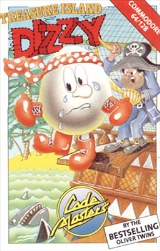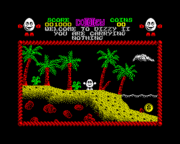
Treasure Island Dizzy
Encyclopedia
Treasure Island Dizzy is a computer puzzle game published in 1987 by Codemasters
for the Amstrad
, Commodore 64
, Spectrum
, DOS
, NES
, Amiga
and Atari ST
.
Treasure Island Dizzy was the second game in the Dizzy series, and is the sequel to Dizzy – The Ultimate Cartoon Adventure. The game was developed by the Oliver Twins
with graphics being designed by Neil Adamson and music by David Whittaker.
 This game is quite different from its predecessor, with a new inventory system and improved animations. The game notably contains fewer enemies than the previous title. It is more centred around inventory based problem solving. The aim of the game is to solve various puzzles in order to obtain a boat so that Dizzy can return to his friends and family, the Yolkfolk. To do this Dizzy must journey through haunted mines, tree villages, as well as underwater. The game also features a subquest (albeit one essential to completing the game) in which thirty gold coins must be collected. Such subquests were found in many of the sequels.
This game is quite different from its predecessor, with a new inventory system and improved animations. The game notably contains fewer enemies than the previous title. It is more centred around inventory based problem solving. The aim of the game is to solve various puzzles in order to obtain a boat so that Dizzy can return to his friends and family, the Yolkfolk. To do this Dizzy must journey through haunted mines, tree villages, as well as underwater. The game also features a subquest (albeit one essential to completing the game) in which thirty gold coins must be collected. Such subquests were found in many of the sequels.
Critics consider this one of the most difficult Dizzy games as the energy bar system of later titles was not yet implemented and Dizzy is provided with only one life—contrasting with five in the first game and three in Fantasy World Dizzy
, the immediate sequel, and most subsequent titles. Also unique to this game, the player is unable to select any particular item from the inventory for use—Dizzy simply puts down whichever item is at the top of the list. If Dizzy is underwater and the snorkel happens to be at the top of the inventory list, he will drop the snorkel when the player collects another item and instantly die. Treasure Island Dizzy therefore requires more foresight and planning than the other games in the series.
Adding to the difficulty of the game was the fact that the player had two main tasks to complete; the escape from the islands, and the collection of the thirty coins. Indeed, upon escaping the final island, the Shopkeeper character appears and tells Dizzy that he cannot leave without finding all thirty coins. Given that a number of the coins were hidden behind scenery, this second task proved to be more difficult than the main game. Commodore Format
printed a "complete" solution and map which did not include the hidden coins, frustrating many a player.
There is a version for the Enterprise 64/128 machines. As a platform the Enterprise was long dead in the UK market by the time the Dizzy games appeared. However it was a popular platform in Hungary as most of the unsold stock ended up there, many popular ZX Spectrum games were ported by Hungarian enthusiasts as few big name software houses supported the machine directly.
Codemasters
The Codemasters Software Company Limited, or Codemasters is a British video game developer founded by Richard and David Darling in 1986...
for the Amstrad
Amstrad
Amstrad is a British electronics company, now wholly owned by BSkyB. As of 2006, Amstrad's main business is manufacturing Sky Digital interactive boxes....
, Commodore 64
Commodore 64
The Commodore 64 is an 8-bit home computer introduced by Commodore International in January 1982.Volume production started in the spring of 1982, with machines being released on to the market in August at a price of US$595...
, Spectrum
ZX Spectrum
The ZX Spectrum is an 8-bit personal home computer released in the United Kingdom in 1982 by Sinclair Research Ltd...
, DOS
DOS
DOS, short for "Disk Operating System", is an acronym for several closely related operating systems that dominated the IBM PC compatible market between 1981 and 1995, or until about 2000 if one includes the partially DOS-based Microsoft Windows versions 95, 98, and Millennium Edition.Related...
, NES
Nintendo Entertainment System
The Nintendo Entertainment System is an 8-bit video game console that was released by Nintendo in North America during 1985, in Europe during 1986 and Australia in 1987...
, Amiga
Amiga
The Amiga is a family of personal computers that was sold by Commodore in the 1980s and 1990s. The first model was launched in 1985 as a high-end home computer and became popular for its graphical, audio and multi-tasking abilities...
and Atari ST
Atari ST
The Atari ST is a home/personal computer that was released by Atari Corporation in 1985 and commercially available from that summer into the early 1990s. The "ST" officially stands for "Sixteen/Thirty-two", which referred to the Motorola 68000's 16-bit external bus and 32-bit internals...
.
Treasure Island Dizzy was the second game in the Dizzy series, and is the sequel to Dizzy – The Ultimate Cartoon Adventure. The game was developed by the Oliver Twins
Oliver Twins
The Oliver Twins are two British brothers, Philip and Andrew Oliver, who started to professionally develop computer games while they were still at school. Their first game, Super Robin Hood for the Amstrad CPC, was published in 1985 by Codemasters...
with graphics being designed by Neil Adamson and music by David Whittaker.
Design

Critics consider this one of the most difficult Dizzy games as the energy bar system of later titles was not yet implemented and Dizzy is provided with only one life—contrasting with five in the first game and three in Fantasy World Dizzy
Fantasy World Dizzy
Fantasy World Dizzy is an arcade adventure video game released in October 1989 by Codemasters and designed by the Oliver twins.The game is considered the third in the Dizzy series and was developed under the name Dizzy III...
, the immediate sequel, and most subsequent titles. Also unique to this game, the player is unable to select any particular item from the inventory for use—Dizzy simply puts down whichever item is at the top of the list. If Dizzy is underwater and the snorkel happens to be at the top of the inventory list, he will drop the snorkel when the player collects another item and instantly die. Treasure Island Dizzy therefore requires more foresight and planning than the other games in the series.
Adding to the difficulty of the game was the fact that the player had two main tasks to complete; the escape from the islands, and the collection of the thirty coins. Indeed, upon escaping the final island, the Shopkeeper character appears and tells Dizzy that he cannot leave without finding all thirty coins. Given that a number of the coins were hidden behind scenery, this second task proved to be more difficult than the main game. Commodore Format
Commodore Format
Commodore Format was a British magazine for users of the Commodore 64 home computer. All sixty-one issues of the magazine were produced by Future Publishing. These came towards the end of the machine's commercial life - from October 1990 until October 1995....
printed a "complete" solution and map which did not include the hidden coins, frustrating many a player.
Ports
There was some variation between different releases. For example, the C64 release of Treasure Island Dizzy used more primitive graphics than the Atari ST version.There is a version for the Enterprise 64/128 machines. As a platform the Enterprise was long dead in the UK market by the time the Dizzy games appeared. However it was a popular platform in Hungary as most of the unsold stock ended up there, many popular ZX Spectrum games were ported by Hungarian enthusiasts as few big name software houses supported the machine directly.

